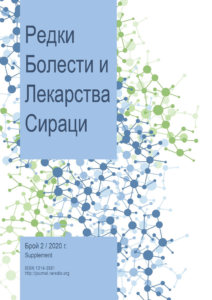 For the 11th consecutive year, the Institute for Rare Diseases organized and held National Conference for Rare Diseases and Orphan Drugs. Participants in a poster session presented their researches on various topics related to rare diseases. This book presents the proceedings of posters and it is published as a supplement on the website of the scientific journal “Rare Diseases and Orphan Drugs”. The e-book can be downloaded or viewed online at the following link.
For the 11th consecutive year, the Institute for Rare Diseases organized and held National Conference for Rare Diseases and Orphan Drugs. Participants in a poster session presented their researches on various topics related to rare diseases. This book presents the proceedings of posters and it is published as a supplement on the website of the scientific journal “Rare Diseases and Orphan Drugs”. The e-book can be downloaded or viewed online at the following link.
Publications
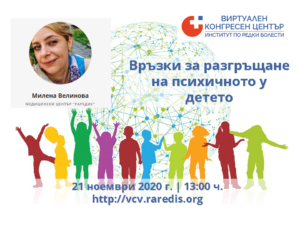 On 21 November, 2020 at 1 pm in hall Maritsa, psychologist Milena Velinova will present a lecture about ” Links for the development of the mental in the child”. The webinar is intended for parents and all interested medical professionals, representatives of the academy, health authorities, patient organizations. The main topic of the lecture is the process of mental development from early childhood to school age.
On 21 November, 2020 at 1 pm in hall Maritsa, psychologist Milena Velinova will present a lecture about ” Links for the development of the mental in the child”. The webinar is intended for parents and all interested medical professionals, representatives of the academy, health authorities, patient organizations. The main topic of the lecture is the process of mental development from early childhood to school age.
At this link you can register for the event for free.
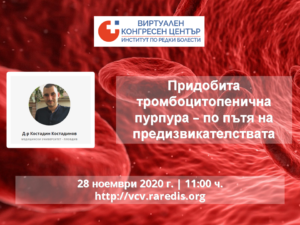 On 28 November, 2020 at 11 am in hall Burgas of the Virtual Congress Venue, Dr. Kostadin Kostadinov will present a lecture about ” Acquired thrombotic thrombocytopenic purpura – on the path of challenges”. The webinar aims to analyze epidemiological data for acquired thrombocytopenic purpura. As well to present an assessment for the prevalence of this disease in Bulgaria. The lecture is intended for all interested medical professionals, academia representatives, health authorities and patient organizations.
On 28 November, 2020 at 11 am in hall Burgas of the Virtual Congress Venue, Dr. Kostadin Kostadinov will present a lecture about ” Acquired thrombotic thrombocytopenic purpura – on the path of challenges”. The webinar aims to analyze epidemiological data for acquired thrombocytopenic purpura. As well to present an assessment for the prevalence of this disease in Bulgaria. The lecture is intended for all interested medical professionals, academia representatives, health authorities and patient organizations.
At this link you can register for the event for free.
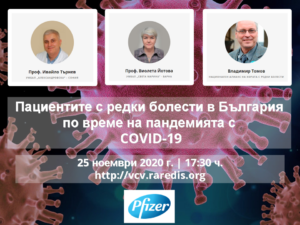
On 25 November, 2020 at 17:30 in hall Dunav of the Virtual Congress Venue, in a specialized webinar, Prof. Ivaylo Tarnev, Prof. Violeta Yotova and Mr. Vladimir Tomov will present a lecture about “Patients with rare diseases in Bulgaria during the COVID-19 pandemic”. The webinar is intended for medical professionals and aims to provide information on how to ensure and optimize therapy and access to it during a COVID-19 pandemic. What is the viewpoint of patients and their new challenges during the COVID-19 pandemic. How we could improve the process of diagnosing, monitoring and treating patients with rare diseases in Bulgaria during the COVID-19 pandemic will be also discussed.
At this link you can register for the event for free.
A new series of interesting topics is starting at the Virtual Congress Venue of the Institute of Rare Diseases.
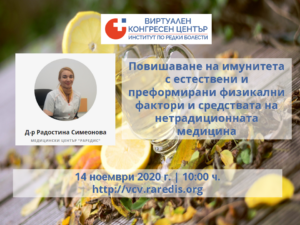 On 14 November, 2020 at 10 am in hall Pleven, Dr. Radostina Simeonova will present a lecture about “Increasing immunity with natural and reshaped physical factors and the means of alternative medicine.” The webinar is intended for all interested medical professionals, representatives of the academy, health authorities and patient organizations. The discussion will be about methods on how to use natural climatic factors to increase non-specific immunity. Physical procedures to help patients at home. Aromatherapy and immunity. Electromagnetic effects, brain activity and emotions. Movement as a therapeutic and prophylactic tool.
On 14 November, 2020 at 10 am in hall Pleven, Dr. Radostina Simeonova will present a lecture about “Increasing immunity with natural and reshaped physical factors and the means of alternative medicine.” The webinar is intended for all interested medical professionals, representatives of the academy, health authorities and patient organizations. The discussion will be about methods on how to use natural climatic factors to increase non-specific immunity. Physical procedures to help patients at home. Aromatherapy and immunity. Electromagnetic effects, brain activity and emotions. Movement as a therapeutic and prophylactic tool.
At this link you can register for the event for free.
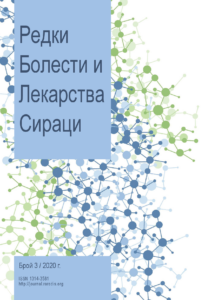 Acquired thrombotic thrombocytopenic purpura (аTTP) is a rare disease with a variety of clinical manifestations, including fever, anemia, thrombocytopenia, neurological symptoms and acute renal injury. This condition was first described in 1924. Nowadays the pathophysioimmunological aspects that distinguish aTTP from other thrombotic vasculopathies serve as a target for innovative therapies. TTP consists of hereditary and acquired types. The acquired one could be further divided into idiopathic and secondary. The current classification of the World Health Organization puts TTP in the category of thrombotic microangiopathies.The epidemiological study of aTTP is a difficult process due to a number of objective factors. This condition is characterized by a distinctive laboratory immunological panel, which is often missing in most clinical centres. The presence of severe clinical presentations, common comorbidities and rapid lethal progression are also obstacles to understand aTTP’s real-world prevalence.This publication aims to analyse the available epidemiological data on aTTP, as well as to provide an estimate of this condition’s prevalence in Bulgaria. Read the whole article here.
Acquired thrombotic thrombocytopenic purpura (аTTP) is a rare disease with a variety of clinical manifestations, including fever, anemia, thrombocytopenia, neurological symptoms and acute renal injury. This condition was first described in 1924. Nowadays the pathophysioimmunological aspects that distinguish aTTP from other thrombotic vasculopathies serve as a target for innovative therapies. TTP consists of hereditary and acquired types. The acquired one could be further divided into idiopathic and secondary. The current classification of the World Health Organization puts TTP in the category of thrombotic microangiopathies.The epidemiological study of aTTP is a difficult process due to a number of objective factors. This condition is characterized by a distinctive laboratory immunological panel, which is often missing in most clinical centres. The presence of severe clinical presentations, common comorbidities and rapid lethal progression are also obstacles to understand aTTP’s real-world prevalence.This publication aims to analyse the available epidemiological data on aTTP, as well as to provide an estimate of this condition’s prevalence in Bulgaria. Read the whole article here.
 Narcolepsy is a neurological disease characterized by chronic, excessive, daytime sleepiness, cataplexy, hypnagogic hallucinations, and sleep paralysis. Type 1 narcolepsy (narcolepsy with cataplexy) has been linked to low levels of a specific neurotransmitter called hypocretin (orexin), which is responsible for regulating sleep, appetite and body temperature. In people with narcolepsy the number of hypocretin-producing neurons is significantly reduced, and in some individuals the missing neurons reach 80-90%. The main clinical manifestations are excessive daytime sleepiness and disturbed sleep during the REM phase. Sleep paralysis, cataplexy, and hypnagogic hallucinations are also manifestations of narcolepsy.In addition to medical treatment, nutrition is an important part. In order, to prevent obesity in patients with narcolepsy, it is necessary to establish a balanced diet, physical activity and sleep, fully consistent with their condition. Orexin secretion could be increased by higher intake of protein, fiber, omega-3 fatty acids, lactate, fructose, fermented foods and physical activity. Orexin secretion is reduced by sugar intake. Recommended micronutrients for narcolepsy control are calcium, magnesium, choline, omega-3 fatty acids, B vitamins, vitamin C. In addition to the type of food consumed, eating habits also have an impact. Skipping breakfast and irregular eating patterns are also associated with poor sleep quality. Treatment should be completed by an adequate lifestyle and diet, including a balanced intake of macro- and micronutrients, physical activity and quality sleep. Read the whole article here.
Narcolepsy is a neurological disease characterized by chronic, excessive, daytime sleepiness, cataplexy, hypnagogic hallucinations, and sleep paralysis. Type 1 narcolepsy (narcolepsy with cataplexy) has been linked to low levels of a specific neurotransmitter called hypocretin (orexin), which is responsible for regulating sleep, appetite and body temperature. In people with narcolepsy the number of hypocretin-producing neurons is significantly reduced, and in some individuals the missing neurons reach 80-90%. The main clinical manifestations are excessive daytime sleepiness and disturbed sleep during the REM phase. Sleep paralysis, cataplexy, and hypnagogic hallucinations are also manifestations of narcolepsy.In addition to medical treatment, nutrition is an important part. In order, to prevent obesity in patients with narcolepsy, it is necessary to establish a balanced diet, physical activity and sleep, fully consistent with their condition. Orexin secretion could be increased by higher intake of protein, fiber, omega-3 fatty acids, lactate, fructose, fermented foods and physical activity. Orexin secretion is reduced by sugar intake. Recommended micronutrients for narcolepsy control are calcium, magnesium, choline, omega-3 fatty acids, B vitamins, vitamin C. In addition to the type of food consumed, eating habits also have an impact. Skipping breakfast and irregular eating patterns are also associated with poor sleep quality. Treatment should be completed by an adequate lifestyle and diet, including a balanced intake of macro- and micronutrients, physical activity and quality sleep. Read the whole article here.
 Aim: To assess the pharmacists’ role in the timely identification of actual and potential drug-related problems (DRPs) in the course of drug dispense, in optimizing therapy and in monitoring the acromegaly patients’ condition.
Aim: To assess the pharmacists’ role in the timely identification of actual and potential drug-related problems (DRPs) in the course of drug dispense, in optimizing therapy and in monitoring the acromegaly patients’ condition.
Material and methods: A review of the scientific literature has been performed. A review and analysis of the summary of product characteristics of medicinal products used in patients with acromegaly, the pharmacotherapeutic guidelines and guidelines for the inclusion of the pharmacist in the overall care for acromegaly patients were performed. The review resulting in proposing key steps and an algorithm for integration of community pharmacists into care for patients with acromegaly.
Results: The pharmacist has a crucial role in timely identification of actual and potential DRPs. Possible DRPs among acromegaly patients are adverse drug reaction (ADRs), drug-drug interactions, non-adherence to therapy, wrong application and storage of medicines. Problems related to injection application could be minimized through effective patients’ education about injection technique and regimen. The main ADRs specific for somatostatin analogues (SSA) are digestive problems, hyperglycemia, diabetes, increased levels of liver enzymes. Beta-blockers and antidiabetic medications dose correction is needed due to possible interactions with SSA. The main factors for non-adherence to therapy on which the pharmacist should focus on are adverse effects, lack of symptoms, financial problems, lack of motivation, inappropriate administration and inconvenient route of administration.
Conclusions: The choice of the most appropriate therapy for every patient, the multidisciplinary approach, the active participation of the pharmacist in the identification and prevention of DRPs and long-term monitoring are the keys for achieving the therapeutic goals in acromegaly patients. Read the whole article here.
 Mandibular gunshot wounds are aesthetically and functionally devastating, causing broken fractures and destruction of adjacent tissue depending on the size of the weapon. In this article, we present a case of a 46-year-old patient who was admitted as a matter of urgency after a suicide attempt with a modified gas pistol. The patient made a shot in the area of the chin of the lower jaw. A review X-ray of the skull – full face profile revealed a fracture of the mentum mandible with fragmentation. Intermaxillary fixation was also placed intraorally, by placing standard Vassilev splints and soft fixation. On the 3rd day after the operation, a control graph was made to assess the stability of fixation and stabilization. Read the whole article here.
Mandibular gunshot wounds are aesthetically and functionally devastating, causing broken fractures and destruction of adjacent tissue depending on the size of the weapon. In this article, we present a case of a 46-year-old patient who was admitted as a matter of urgency after a suicide attempt with a modified gas pistol. The patient made a shot in the area of the chin of the lower jaw. A review X-ray of the skull – full face profile revealed a fracture of the mentum mandible with fragmentation. Intermaxillary fixation was also placed intraorally, by placing standard Vassilev splints and soft fixation. On the 3rd day after the operation, a control graph was made to assess the stability of fixation and stabilization. Read the whole article here.
 Surgical therapy is the main option for the treatment of tongue cancer, while radiation therapy and chemotherapy are additional concomitant therapies. In this article, we present a case of a patient admitted for treatment with suspected cancer of the tongue. Lateral surface of the tongue on the right side during the examination revealed the presence of a lesion measuring 3.5×2.5. After histological examination, the patient was diagnosed with invasive highly differentiated keratinized squamous cell carcinoma of the tongue. Hemiglosectomy was performed, preserving the lingual artery, without neck lymph dissection. Postoperatively, the patient was prescribed radiotherapy of 30 grays in total. Read the whole article here.
Surgical therapy is the main option for the treatment of tongue cancer, while radiation therapy and chemotherapy are additional concomitant therapies. In this article, we present a case of a patient admitted for treatment with suspected cancer of the tongue. Lateral surface of the tongue on the right side during the examination revealed the presence of a lesion measuring 3.5×2.5. After histological examination, the patient was diagnosed with invasive highly differentiated keratinized squamous cell carcinoma of the tongue. Hemiglosectomy was performed, preserving the lingual artery, without neck lymph dissection. Postoperatively, the patient was prescribed radiotherapy of 30 grays in total. Read the whole article here.
